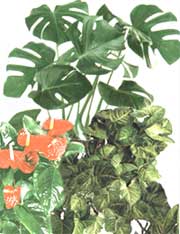Araceae / Araceae
General description: Araceae family of plants have beautiful leaves and buds on the cob. The leaves are arranged alternately on the stem, petiole base as if covering the stem. The size, shape, color of leaves and flowers vary greatly.
For decorative and deciduous are Monstera, dieffenbachia, philodendron and others.
For decorative and flowering are spatifillyum, anthurium and other.
We can distinguish three groups of Araceae:
bushy
These include the popular Dieffenbachia, but it looks like Anthurium, Alokaziya, Aglaonema, spatifillyum and others. These are usually large plants did not need, but in the pole. They do not own pronounced period of rest.
Liana
Among the most famous Monstera, Philodendron, and Epipremnum Syngonium. They have aerial roots and need support, better with frequent beams to whip not entangled. You can use a club wrapped with moss. Often, they seem to grow as if the basket plant. They seem a bit pronounced dormancy.
tuberous
It is allowed to call Zamiakulkas, Amorfofallyus, Sauromatum, Caladium.
In the period of inactivity, they completely lose their leaves.
Recommendations for the care of Araceae plants:
Lighting: light-requiring, in the warm time of the year prefer diffused light in the winter useful to direct sunlight, it is better to own them closer to the southern windows.
Watering Mode: In the period of growth abundant watering (except Zamioculcas, it poured like all succulents). In winter, watering sparingly. Gordo does not tolerate drying out the land. Tuberous not watered in the winter, usually kept trimmed and removed from the land.
Humidity: Requires frequent spraying, especially in warm rooms.
Earth in a pot and stems useful to impose-wet sphagnum moss. Eliminate from the central heating.
Temperature: Moderate, cool in winter.
Soil: Draining required. You can add charcoal and brick chips.
Recommended soil mishmash: 1 proportion of sod land, 1 share of humus, ground sheet 1 share and 1 share of sand.
Breeding: Liana easily rooted by layering with aerial roots or cuttings. In tuberous at the source of a period of inactivity separate subsidiaries bulbs that are planted in the spring. You can sow the seeds but only fresh, they quickly lose their germination.
Transplanting: bushy Araceae usually can not tolerate a transplant was ill continuously, so you should repot and divide the bushes just in case tightness pot spring.
Some, on the contrary, can easily tolerate a transplant (Syngonium, Epipremnum, Amorfofallyus).
Pests: rarely affected.

Araceae - Araceae


Comments
Commenting, keep in mind that the content and the tone of your messages can hurt the feelings of real people, show respect and tolerance to his interlocutors, even if you do not share their opinion, your behavior in terms of freedom of speech and anonymity offered by the Internet, is changing not only virtual, but real world. All comments are hidden from the index, spam control.